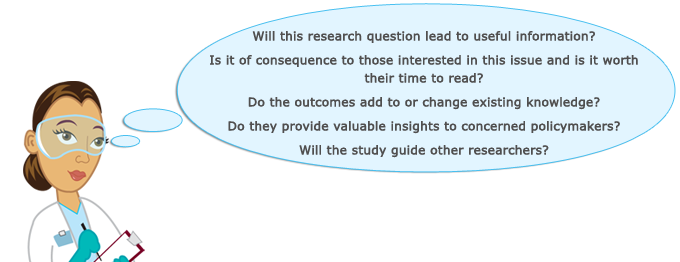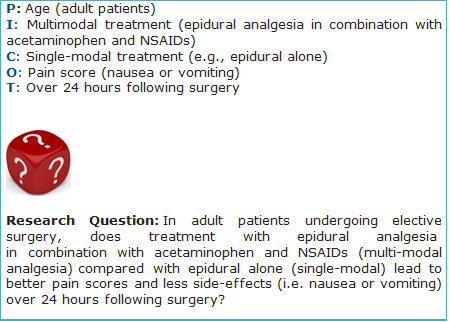Finding the right research question is the first step to successful publication

The first and most important step when writing an academic paper is choosing a topic that will advance knowledge and add another building block to the study of science and humanity. As a corollary, it’s quite unlikely that a journal editor will accept a paper that does not have a good research question.
A clearly defined research question increases chances of publication, because it gives the researchers greater clarity on developing the study protocol, designing the study, and analyzing the data.1,2 A well-defined research question also makes a good initial impression on journal editors and peer reviewers. In contrast, a poorly formulated research question can seriously harm your chances of publication, among other adverse effects, because it can easily lead to the perception that the research wasn’t well thought out.3
Although a single paper can address more than one research question, it is good practice to focus on one primary research question.3 So what makes a good research question? While the answer may vary for different types of papers and across disciplines, there are a few overall criteria that you should keep in mind, whether you are writing about Shakespeare, stem cells, or steel processing.
So what?
First and foremost, any research question should pass the “so what?” test4: the findings that result from pursuing this question must be important, interesting, and meaningful. Once you have determined the possible outcomes of your research, always ask yourself “So what?”

Lack of originality in findings - in other words, “novelty” - is one of the most common reasons for rejection by journals. Editors of scientific journals stress on novelty and “unobviousness”; the research question should not already have an obvious or undisputed answer.4,5 As some journals reject up to 90% of the papers submitted for publication, it is important to ensure that your paper stands out and provides value in one of the following ways6:
- contributes new information that has real-world application or leads to further lines of research,
- corroborates existing information and extends their generalizability or applicability,
- provides findings that contradict the literature, or
- critically reviews and analyzes the literature.
Good research questions can arise from critical thinking about current practices and problems, from applying new concepts or methods to old problems, and from ideas that emerge when you teach your subject to others. 7
Replication is acceptable...sometimes
Not all papers convey absolutely unknown information. For instance, it may be interesting to know whether other researchers’ observations can be replicated (especially if the observations were controversial or weak but significant), whether the findings in one population also apply to others, or to clarify known relationships by using new methodologies. A study that validates the findings of other ones while doing away with their limitations can also be very useful.7
If your findings are likely to fulfill the above three requirements, you’ve probably got a worthwhile research question.
Tips for finding and formulating good research questions
Clinical or field experience, as well as your own research interests, are obviously important in identifying potential lines of research. However, a thorough review of the existing literature is always critical to make sure your question hasn’t become irrelevant. In addition, keep abreast of current developments in the field to avoid doing the very same thing someone else has done (with the enormous amount of scientific output being produced nowadays, this is not an unlikely scenario).
You can also find new research questions from the literature. For instance, the Discussion section of many papers often mentions unresolved questions and additional experiments or studies that can be done. In particular, if the conclusions or generalizability of another study has attracted a lot of controversy, you could attempt to replicate the study in order to validate its results.4 In sum, a good research question can arise when you identify gaps and weaknesses in the existing literature.
There are a number of other ways of finding a good research question. Attending conferences is one of them. Recent advances in a particular field may be presented at academic conferences or just be known to active researchers in a particular field long before they are published.7 Thus, participating in such conferences and networking with experts in the field can be a valuable aid in your own research. Invitations for research proposals by funding bodies can also give you specific research ideas that are likely to be approved for funding.
Specific frameworks have been developed to help researchers formulate research questions step by step and factor by factor. Examples of such frameworks are PICOT, PESICO, and FINER.3,8 Using these templates can give researchers, especially young researchers, a structured method for brainstorming and finalizing their research questions.
PICOT: Population, Intervention, Control, Outcome, Time Frame
PESICO: Person/problem, Environments, Stakeholders, Intervention, Comparison, Outcomes
FINER: Feasible, Interesting, Novel, Ethical, Relevant
SPICE: Setting, Population, Intervention, Comparison, Evaluation
Using PICOT to build the research question

Source: Thabane et al. (2009)3
Using PICOES to build the research question
Source: Schlosser, Koul, & Costello (2007)8
Finally, a young researcher can greatly benefit from having a good mentor. A senior colleague who not only has more experience in doing studies but also whose work is published in peer-reviewed journals can provide very valuable advice. Another excellent guide would be a statistician, who can guide you in choosing the right sample size, units of analysis, and determinants of statistical significance.
Conclusion
To conclude, the research question is the most crucial element of any academic paper and the first and most important stage in the publication process. A paper with results that are unoriginal, predictable, or trivial is less likely to be published.
Further, it may be of no use to rewrite or change the presentation of your paper if your study has “used the wrong model or study design, collected data in a manner that would not allow a meaningful examination of the hypothesis, or made too few measurements to permit confident conclusions to be drawn.”9 Spending time to develop a well-formulated research question will help you avoid these problems.
- Sackett DL & Wennberg JE (1997). Choosing the best research design for each question. BMJ, 315: 1636. [Publisher]
- Stone P (2002). Deciding upon and refining a research question. Palliative Medicine, 16: 265–7.
- Thabane L, Thomas T, Ye C, Paul J (2009). Posing the research question: Not so simple. Canadian Journal of Anaesthesia, 56(1): 71-9. doi: 10.1007/s12630-008-9007-4.
- Kwiatkowski T & Silverman R (1998). Research fundamentals: II. Choosing and defining a research question. Academic Emergency Medicine,5(11): 1114-7.
- Ali J (2010). Manuscript rejection: causes and remedies. Journal of Young Pharmacists, 2(1): 3-6. doi: 10.4103/0975-1483.62205.
- Cook C, Brismée J-M, Courtney C, Hancock M, May S (2009). Publishing a scientific manuscript on manual therapy. The Journal of Manual & Manipulative Therapy, 17(3): 141-7.
- Cummings SR, Browner WS, & Hulley SB (2006). Conceiving the research question. Designing Clinical Research, Third Edition, pp. 17-23. Wolters Kluwer Health: Philadelphia.
- Schlosser RW, Koul R, Costello J (2007). Asking well-built questions for evidence-based practice in augmentative and alternative communication. Journal of Communication Disorders, 40(3): 225-38. doi: 10.1016/j.jcomdis.2006.06.008.
- Pierson DJ (2004). The top 10 reasons why manuscripts are not accepted for publication. Respiratory Care, 49(10), 1246-52.
Published on: Oct 16, 2013
Comments
You're looking to give wings to your academic career and publication journey. We like that!
Why don't we give you complete access! Create a free account and get unlimited access to all resources & a vibrant researcher community.

Subscribe to Conducting Research













